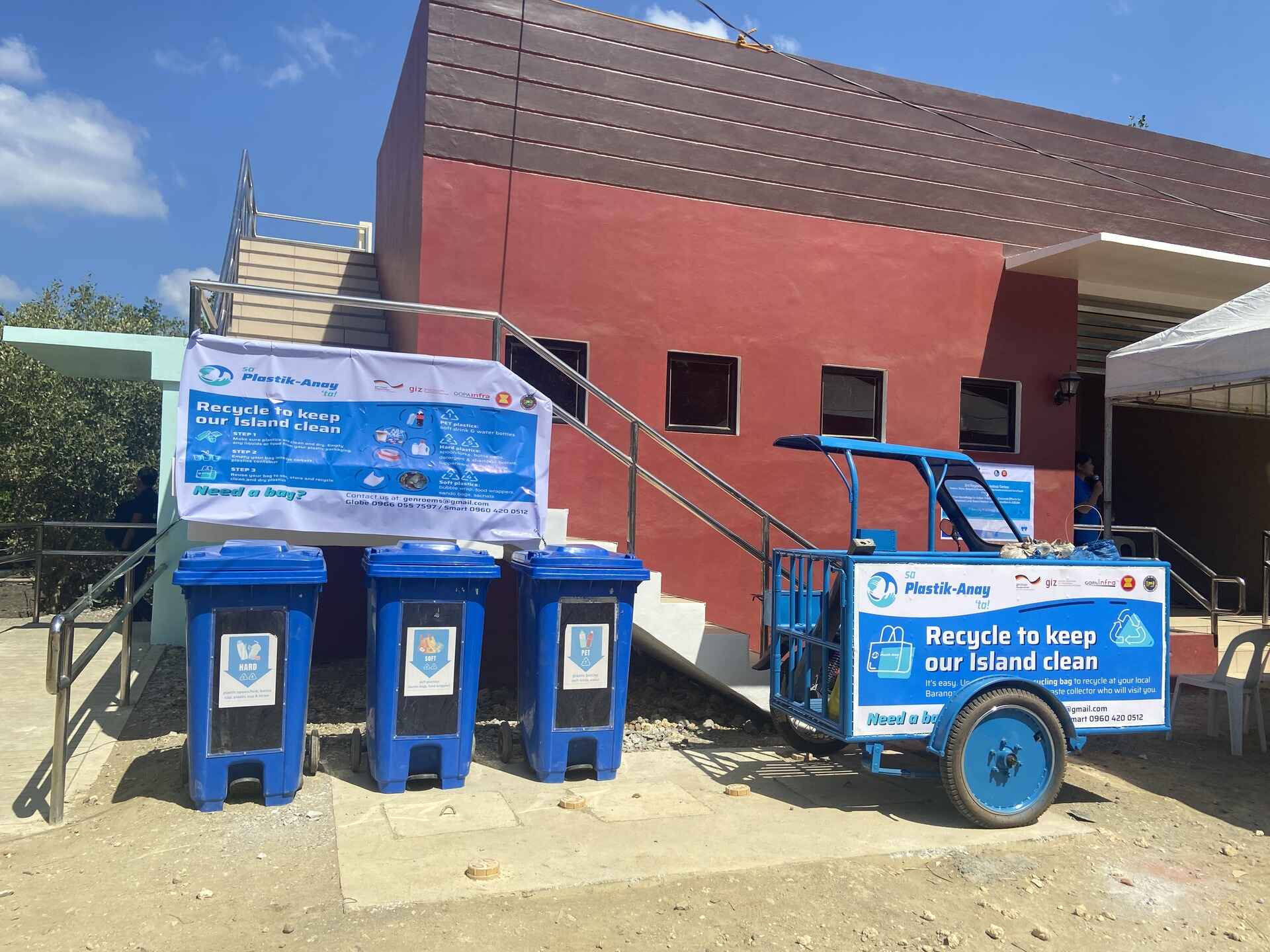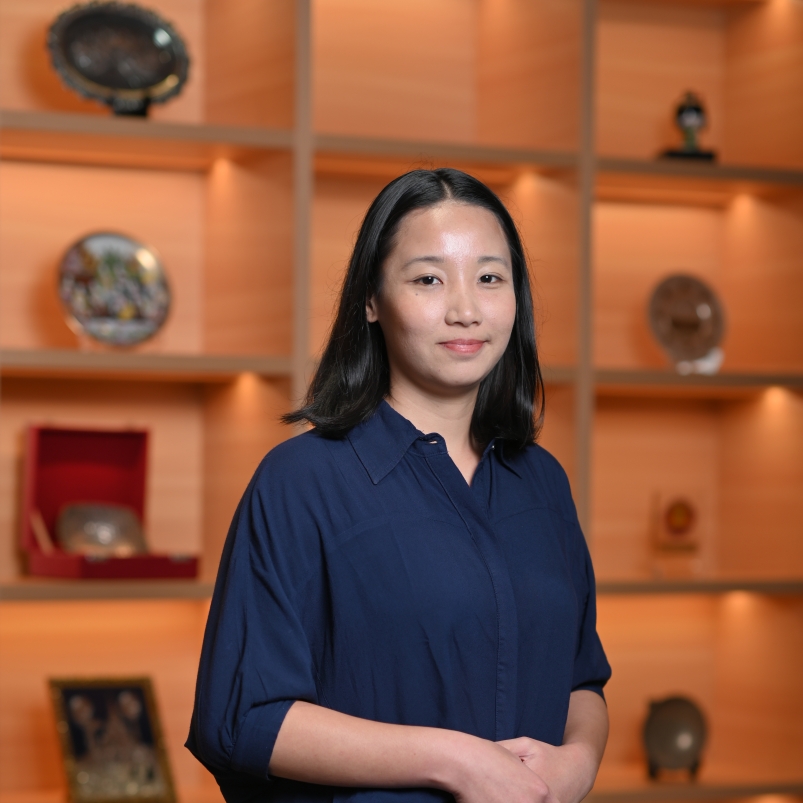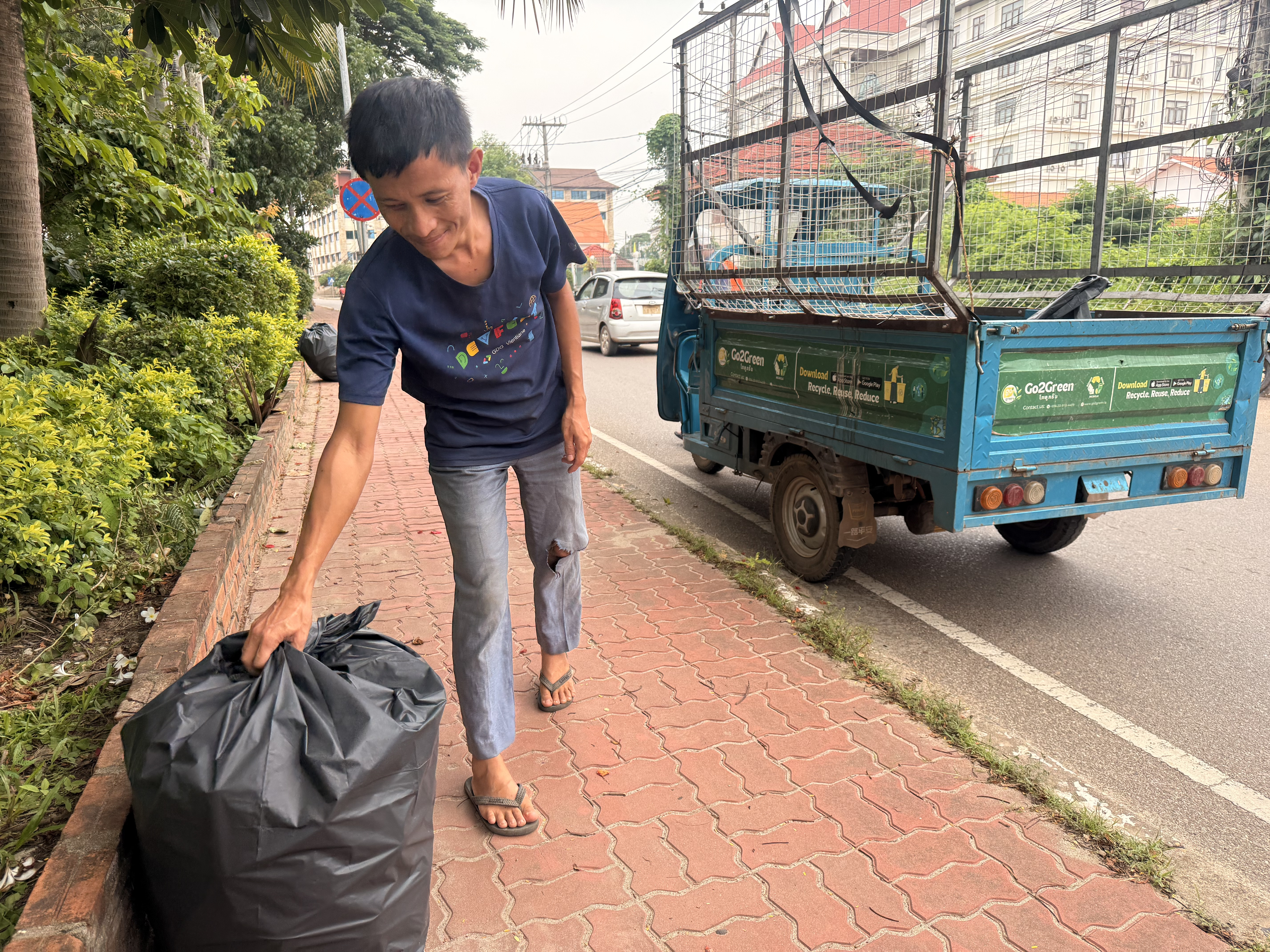

Guimaras Island, 22 March 2024: Participants of the 3rd Regional Workshop of the Reduce, Reuse and Recycle to Protect the Marine Environment and Coral Reefs (3RproMar) project under Deutsche Gesellschaft für Internationale Zusammenarbeit (GIZ) visited the island province of Guimaras to explore its nature reserve, learn more about its waste management practices, and taste its world-famous mangoes.
Upon arrival at Jordan Wharf after a short boat ride from Iloilo City, where the majority of the GIZ 3RproMar Workshop activities were held, participants were greeted by a mango monument, signalling arrival at the Mango Capital of the Philippines. Participants will agree that the province's nickname is definitely befitting after passing stall after stall fully stacked with mangoes along the roadside, and mango plantations throughout the drive from the wharf to Taklong Island National Marine Reserve (TINMR) at the southern end of the island.
TINMR, situated in barangays* La Paz and San Roque of Nueva Valencia Municipality, covers a total area of 1,143.45 hectares encompassing 46 islands and islets, and hosts a variety of natural ecosystems including mangroves, coral reefs, and seagrass meadows. The rich variety of ecosystems in the national reserve not only make it home to a high number of wildlife species, but also as a popular eco-tourism destination where tourists can engage in activities ranging from island hopping and snorkelling to bird watching.
After welcoming remarks from the Governor of Guimaras, Gov Joaquin Carlos Rahman A Nava, workshop participants had the opportunity to explore one of the marine reserve islands, enjoy a lunch of local cuisines and, of course, the Guimaras mangoes, as well as listen to presentations on the province's marine reserve and waste management system.
Guimaras Province implements a systematic waste management process that engages stakeholders from households up to the provincial level. Under this system, households compost organic waste in their backyards while recyclable waste is collected by junk buyers. This leaves residual waste which is brought to collection boxes at the sitio** level, where an officer records the amount of waste deposited by each household in a notebook. This form of documentation is important to generate waste-related data from the lowest administrative level that is useful for monitoring the implementation of extended producer responsibility (EPR) in the country. Waste from the sitios is then brought to a materials recovery facility, the municipal eco solid waste management park, and the province’s integrated waste management facility, before the consolidated plastics are delivered to the appropriate recycling facilities.
After visiting the TINMR, the participants were brought to the treatment, sorting, and disposal facility (TSDF) and the Sapal Weavers Association. At the TSDF, staff members demonstrated how collected residual plastics are processed and used to create plastic furniture. In the facility, combinations of LDPE, PP, HDPE, PS, and flexible plastics are sorted, shredded, melted, and then moulded into plastic lumber to become the raw materials for building furniture such as tables and chairs.
At present, the furniture is not produced for commercial purposes, but is supplied to schools in the surrounding area. The Sapal Weavers Association aims to bring back weaving, which used to be commonly practiced in the Philippines, and encourage it as a livelihood project for communities, while also promoting the use of organic materials, namely mangrove leaves, as an alternative to plastics.
Photo: A staff member of the treatment, sorting, and disposal facility demonstrates the process of making plastic lumber out of residual plastic waste.
Although Guimaras Province seems to have a robust waste management system in place, it is still at the early stages and faces its own series of challenges, including those related to transporting waste across the region and the high associated costs. The province has planned a route for the efficient collection and transportation of waste across the main island and part of the cost is covered by households, proportional to the amount of waste deposited.
However, collecting waste from the smaller surrounding islands is challenging and costly. Processing the waste, such as producing plastic lumber, also has its own costs. Although current fees collected under EPR schemes are enough to cover the electricity bills, hopefully a more effective implementation of EPR can help further generate funds to sustain the project.
At the end of the day, as the workshop participants board the boat to go back to Iloilo City, they bring along with them many souvenirs from their visit to Guimaras Island. Some carry weaved bags and pouches skilfully crafted by the women of the island; and some bring snacks and delicacies made from the island’s sweet and juicy mangoes. Most importantly, they also bring with them a better understanding of the realities of waste management in rural coastal areas, specifically the challenges and opportunities, which is very relevant to many other locations across the Southeast Asian region.
This visit to the Guimaras Island was conducted as part of the GIZ 3RproMar 3rd Regional Workshop, held in Iloilo City, the Philippines from 19–23rd March 2024. The ERIA Regional Knowledge Centre for Marine Plastic Debris (the Centre) is involved in the GIZ 3RproMar project as part of a partnership for promoting regional cooperation and knowledge management on marine litter and plastic pollution.
*Barangay: An administrative division in the Philippines equivalent to a village.
**Sitio: An administrative division in the Philippines at the level below barangay.
Guimaras Island, 22 March 2024: Participants of the 3rd Regional Workshop of the Reduce, Reuse and Recycle to Protect the Marine Environment and Coral Reefs (3RproMar) project under Deutsche Gesellschaft für Internationale Zusammenarbeit (GIZ) visited the island province of Guimaras to explore its nature reserve, learn more about its waste management practices, and taste its world-famous mangoes.
Upon arrival at Jordan Wharf after a short boat ride from Iloilo City, where the majority of the GIZ 3RproMar Workshop activities were held, participants were greeted by a mango monument, signalling arrival at the Mango Capital of the Philippines. Participants will agree that the province's nickname is definitely befitting after passing stall after stall fully stacked with mangoes along the roadside, and mango plantations throughout the drive from the wharf to Taklong Island National Marine Reserve (TINMR) at the southern end of the island.
TINMR, situated in barangays* La Paz and San Roque of Nueva Valencia Municipality, covers a total area of 1,143.45 hectares encompassing 46 islands and islets, and hosts a variety of natural ecosystems including mangroves, coral reefs, and seagrass meadows. The rich variety of ecosystems in the national reserve not only make it home to a high number of wildlife species, but also as a popular eco-tourism destination where tourists can engage in activities ranging from island hopping and snorkelling to bird watching.
After welcoming remarks from the Governor of Guimaras, Gov Joaquin Carlos Rahman A Nava, workshop participants had the opportunity to explore one of the marine reserve islands, enjoy a lunch of local cuisines and, of course, the Guimaras mangoes, as well as listen to presentations on the province's marine reserve and waste management system.
Guimaras Province implements a systematic waste management process that engages stakeholders from households up to the provincial level. Under this system, households compost organic waste in their backyards while recyclable waste is collected by junk buyers. This leaves residual waste which is brought to collection boxes at the sitio** level, where an officer records the amount of waste deposited by each household in a notebook. This form of documentation is important to generate waste-related data from the lowest administrative level that is useful for monitoring the implementation of extended producer responsibility (EPR) in the country. Waste from the sitios is then brought to a materials recovery facility, the municipal eco solid waste management park, and the province’s integrated waste management facility, before the consolidated plastics are delivered to the appropriate recycling facilities.
After visiting the TINMR, the participants were brought to the treatment, sorting, and disposal facility (TSDF) and the Sapal Weavers Association. At the TSDF, staff members demonstrated how collected residual plastics are processed and used to create plastic furniture. In the facility, combinations of LDPE, PP, HDPE, PS, and flexible plastics are sorted, shredded, melted, and then moulded into plastic lumber to become the raw materials for building furniture such as tables and chairs.
At present, the furniture is not produced for commercial purposes, but is supplied to schools in the surrounding area. The Sapal Weavers Association aims to bring back weaving, which used to be commonly practiced in the Philippines, and encourage it as a livelihood project for communities, while also promoting the use of organic materials, namely mangrove leaves, as an alternative to plastics.
Photo: A staff member of the treatment, sorting, and disposal facility demonstrates the process of making plastic lumber out of residual plastic waste.
Although Guimaras Province seems to have a robust waste management system in place, it is still at the early stages and faces its own series of challenges, including those related to transporting waste across the region and the high associated costs. The province has planned a route for the efficient collection and transportation of waste across the main island and part of the cost is covered by households, proportional to the amount of waste deposited.
However, collecting waste from the smaller surrounding islands is challenging and costly. Processing the waste, such as producing plastic lumber, also has its own costs. Although current fees collected under EPR schemes are enough to cover the electricity bills, hopefully a more effective implementation of EPR can help further generate funds to sustain the project.
At the end of the day, as the workshop participants board the boat to go back to Iloilo City, they bring along with them many souvenirs from their visit to Guimaras Island. Some carry weaved bags and pouches skilfully crafted by the women of the island; and some bring snacks and delicacies made from the island’s sweet and juicy mangoes. Most importantly, they also bring with them a better understanding of the realities of waste management in rural coastal areas, specifically the challenges and opportunities, which is very relevant to many other locations across the Southeast Asian region.
This visit to the Guimaras Island was conducted as part of the GIZ 3RproMar 3rd Regional Workshop, held in Iloilo City, the Philippines from 19–23rd March 2024. The ERIA Regional Knowledge Centre for Marine Plastic Debris (the Centre) is involved in the GIZ 3RproMar project as part of a partnership for promoting regional cooperation and knowledge management on marine litter and plastic pollution.
*Barangay: An administrative division in the Philippines equivalent to a village.
**Sitio: An administrative division in the Philippines at the level below barangay.

Research Associate



